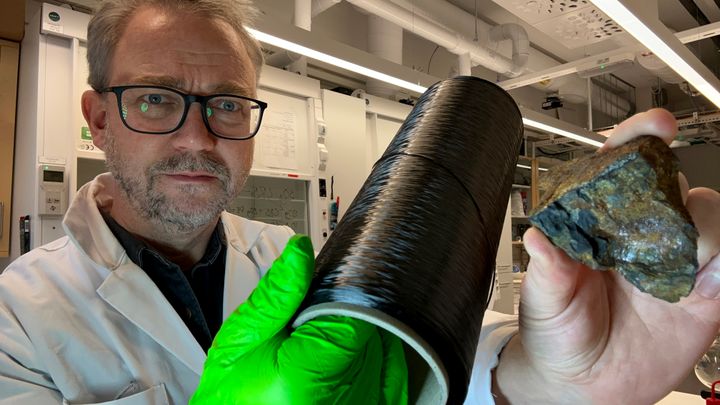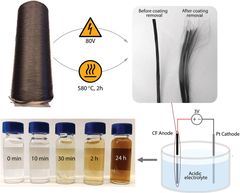For graphene production, a potential green alternative to mining graphite
Researchers in Sweden report a green alternative to reduce reliance on mining graphite, the raw source behind the "wonder material" graphene.

In the latest volume of the scientific journal Small, researchers at KTH Royal Institute of Technology say they have developed a reproducible and scalable method for producing graphene oxide (GO) nanosheets from commercial carbon fibers, marking a breakthrough in sustainable nanomaterial synthesis.
The process involves exfoliating carbon fibers with nitric acid, which provides high yields of one-atom-thick sheets of graphene oxide with characteristics comparable to commercial GO sourced from mined graphite.
Graphene oxide is a widely studied nanomaterial that can be used in car batteries when its thin sheets stack together, forming layers similar to graphite. It is also useful in high-performance composites, water purification and electronic devices. However, synthesis from mined graphite requires harsh chemicals and often results in material inconsistencies due to variations in graphite purity.
Biomass is possible source
Richard Olsson, professor in polymeric materials at KTH, says the proof of concept was carried out with carbon fibers derived from polyacrylonitrile (PAN), a widely available polymer that undergoes high-temperature oxidation and graphitization. He says the method could be duplicated with other raw sources, such as raw sources such as biomass or forest industry sidestreams.
Olsson points to the electric vehicle battery market as one that can benefit from the new technology. “The core of graphite battery functionality can be found in the layered graphene inside, which can be harvested from commercial carbon fibers using this method,” he says.
“The future of auto manufacturing will build on battery-based power, and the question is where the graphite will be sourced? They are going to need alternatives.”
Graphene sheets peel off
The method consists of transforming the carbon fibers using the process of electrochemical oxidation in a bath of water and nitric acid. The bath acts as a conductor and when an electric current is sent through carbon fiber, the material begins to lose electrons which transforms the surface much the same way that oxidization appears as rust on a car. In this case, the transformation causes layers of nanoscale graphene oxide to peel off from the carbon fibers' surface.
The study discovered a window in which just 5 percent nitric acid was perfect for creating these tiny nanosheets, ranging from 0.1 to 1 micrometer in size, with a uniform thickness of about 0.9 nanometers. Notably, the GO nanosheets synthesized this way emerged in circular and elliptical shapes, in contrast to the polygonal shapes typical of GO synthesized from natural, mined graphite.
High yield and quality
Compared to existing synthetic methods, the new approach delivers a high yield of 200 milligrams of GO per gram of carbon fiber. This efficient conversion rate makes it viable for large-scale production, addressing a key challenge in nanomaterial synthesis, he says.
To ensure the nanosheets met quality standards, the researchers examined and measured the properties and structure of the material with a number of advanced techniques.
The study also explored methods to remove protective polymer coatings from commercial carbon fibers before oxidation, heating at 580°C for two hours and shock-heating to 1200°C for three seconds—both proving effective. The research demonstrated that the nature of electrical conduction within the fibers plays a crucial role in the electrochemical exfoliation process.
Olsson says the next steps for the researchers include investigating biobased sources for carbon fibers, delving deeper into how the process works.
###
Making Synthetic 2D Graphene Oxide Nanosheets by Electrochemical Oxidation of Commercial Carbon Fibre, Small, DOI: 10.1002/smll.202408972
Images
Subscribe to releases from KTH Royal Institute of Technology
Subscribe to all the latest releases from KTH Royal Institute of Technology by registering your e-mail address below. You can unsubscribe at any time.
Latest releases from KTH Royal Institute of Technology
Study explains why new kinds of steel needed to build lead cooled reactors11.12.2025 14:23:59 CET | Press Release
Safer operation, better fuel efficiency and lower waste mark lead-cooled nuclear power as a potentially dramatic shift from the water-cooled nuclear stations the world has relied on since the mid 20th century. A recent Swedish study casts new light on how to avoid corrosion in the steel used to build these next-generation nuclear facilities.
Alternative to BPA passes toxicity and sustainability standards set by EU innovation guidelines4.12.2025 11:07:37 CET | Press Release
Polyester and a host of other plastic products could potentially be manufactured with non-toxic and sustainable BPA alternatives identified in a multidisciplinary study published today by researchers in Sweden.
Study shows potential for more affordable and efficient hydrogen gas production3.12.2025 15:29:35 CET | Press Release
A recent advance in the science of hydrogen fuel production could enable higher output and more sustainable production of this renewable energy source, researchers with Stockholm’s KTH Royal Institute of Technology report.
Calcium-sensitive switch designed to boost efficacy of cancer drugs24.11.2025 21:11:53 CET | Press Release
Cancer-fighting antibody drugs are designed to penetrate tumor cells and release a lethal payload deep within, but too often they don’t make it that far. A new study shows how this Trojan Horse strategy works better by exploiting calcium differences outside and inside cells.
Potential treatment may prevent brain damage in premature babies11.11.2025 11:10:46 CET | Press Release
A treatment that could protect premature babies from brain damage showed promise in a recent study in Sweden. Using a first-of-its-kind prenatal brain model created with human cells, researchers observed new details about the effects of cerebral hemorrhages on stem cells during premature birth. And they successfully tested an antidote that reduced the damage.
In our pressroom you can read all our latest releases, find our press contacts, images, documents and other relevant information about us.
Visit our pressroom

